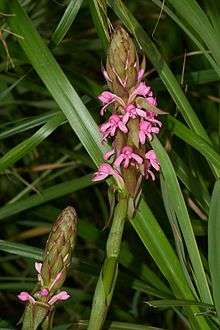South Western Ghats montane rain forests
The South Western Ghats montane rain forests are an ecoregion of southern India, covering the southern portion of the Western Ghats range in Karnataka, Kerala and Tamil Nadu, at elevations over 1000 meters. They are cooler and wetter than the lower-elevation South Western Ghats moist deciduous forests, which surround the montane rain forests.
Setting
The ecoregion is the most species rich in peninsular India, and is home to numerous endemic species. It covers an area of 22,600 square kilometers (8,700 sq mi). It is estimated that two-thirds of the original forests have been cleared, and only 3,200 square kilometers, or 15% of the intact area, is protected.
The southern portion of the Western Ghats contains the highest peaks in the range, notably Anai Mudi in Kerala, at 2695 meters elevation. The Ghats intercept the moisture-laden monsoon winds off the Arabian Sea, and the average annual precipitation exceeds 2,800 mm. The northeast monsoon from October to November supplements the June to September southwest monsoon. The South Western Ghats are the wettest portion of peninsular India, and are surrounded by drier ecoregions to the east and north.
Flora
The cool and moist climate, high rainfall, and variety of microclimates brought about by differences in elevation and exposure supports lush and diverse forests; 35% of the plant species are endemic to the ecoregion. Moist evergreen montane forests are the predominant habitat type. The montane evergreen forests support a great diversity of species. The trees generally form a canopy at 15 to 20 m, and the forests are multistoried and rich in epiphytes, especially orchids. Characteristic canopy trees are Cullenia exarillata, Mesua ferrea, Palaquium ellipticum, Gluta travancorica, and Nageia wallichiana. Nageia is a podocarp conifer with origins in the ancient supercontinent of Gondwana, of which India was formerly part, and a number of other plants in the ecoregion have Gondwana origins. Other evergreen tree species of the montane forest include Calophyllum austroindicum, Garcinia rubro-echinata, Garcinia travancorica, Diospyros barberi, Memecylon subramanii, Memecylon gracile, Goniothalamus rhyncantherus, and Vernonia travancorica.
The other major habitat type in the ecoregion is the shola-grassland complex, found at elevations of 1,900 to 2,220 m. Shola is a stunted forest, with an upper story of small trees, generally Pygeum gardneri, Schefflera racemosa, Linociera ramiflora, Syzygium spp., Rhododendron nilgiricum, Mahonia nepalensis, Elaeocarpus recurvatus, Ilex denticulata, Michelia nilagirica, Actinodaphne bourdellonii, and Litsea wightiana. Below the upper story is a low understory and a dense shrub layer. These shola forests are interspersed with montane grasslands, characterized by frost- and fire-resistant grass species like Chrysopogon zeylanicus, Cymbopogon flexuosus, Arundinella ciliata, Arundinella mesophylla, Arundinella tuberculata, Themeda tremula, and Sehima nervosum.
Fauna
The ecoregion also supports a rich fauna, which is also high in endemism: of 78 mammal species, 10 are endemic, along with 42% of the fishes, 48% of the reptiles, and 75% of the amphibians. Of 309 bird species, 13 are endemic.
The ecoregion supports India's largest elephant population, along with populations of threatened tiger (Panthera tigris), leopard (Panthera pardus), sloth bear (Melursus ursinus), gaur (Bos gaurus), and dhole or Indian wild dog (Cuon alpinus). The rare and endemic Nilgiri tahr (Nilgiritragus hylocrius) is limited to a 400 km band of shola-grassland mosaic, from the Nilgiri Hills in the north to the Agasthyamalai (Ashambu) Hills in the south. The lion-tailed macaque (Macaca silenus) and Nilgiri langur (Semnopithecus johnii) are endangered endemic primate species.
90 of India's 484 reptile species are endemic to the ecoregion, with eight endemic genera (Brachyophidium, Dravidogecko, Melanophidium, Plectrurus, Ristella, Salea, Teretrurus, and Xylophis). Almost 50% of India's 206 amphibian species are endemic to the ecoregion, with six endemic genera (Indotyphlus, Melanobatrachus, Nannobatrachus, Nyctibatrachus, Ranixalus, and Uraeotyphlus).
Protected areas
As of 1997, 13 protected areas were designated, covering an area of over 3,200 km2.[1] Several of the protected areas in the northern portion of the ecoregion are included within the Nilgiri Biosphere Reserve, and the Agasthyamala Biosphere Reserve covers the southern portion.
- Aralam Wildlife Sanctuary, Kerala (50 km2)
- Brahmagiri Wildlife Sanctuary, Karnataka (190 km2)
- Eravikulam National Park, Kerala (97 km2, partly in the South Western Ghats moist deciduous forests)
- Grass Hills National Park, Tamil Nadu
- Indira Gandhi National Park (Anamalai), Tamil Nadu (600 km2, partly in the South Western Ghats moist deciduous forests)
- Kalakkad Mundanthurai Tiger Reserve, Tamil Nadu (290 km2)
- Karian Shola National Park, Tamil Nadu
- Karimpuzha National Park, Kerala (230 km2)
- Megamalai Wildlife Sanctuary, Tamil Nadu (120 km2, partly in the South Western Ghats moist deciduous forests)
- Mukurthi National Park, Tamil Nadu (60 km2)
- Parambikulam Wildlife Sanctuary, Kerala (260 km2)
- Periyar National Park, Kerala (540 km2, partly in the South Western Ghats moist deciduous forests)
- Pushpagiri Wildlife Sanctuary, Karnataka (60 km2, partly in the North Western Ghats montane rain forests)
- Peppara Wildlife Sanctuary, Kerala (40 km2, partly in the South Western Ghats moist deciduous forests)
- Sathyamangalam Wildlife Sanctuary, Tamil Nadu (1611 km2, partly in the South Western Ghats moist deciduous forests)
- Shenduruny Wildlife Sanctuary, Kerala (300 km2)
- Silent Valley National Park, Kerala (110 km2)
- Talakaveri Wildlife Sanctuary, Karnataka (250 km2)
References
- ↑ Wikramanayake, Eric; Dinerstein, Eric; Loucks, Colby J. (2002). Terrestrial Ecoregions of the Indo-Pacific: a Conservation Assessment. Washington, DC: Island Press. p. 326-328. ISBN 978-1559-639-23-1.
External links
- "South Western Ghats montane rain forests". Terrestrial Ecoregions. World Wildlife Fund.
 Media related to Western Ghats at Wikimedia Commons
Media related to Western Ghats at Wikimedia Commons

